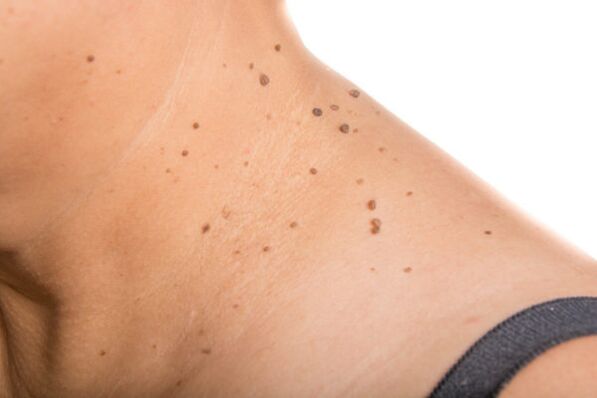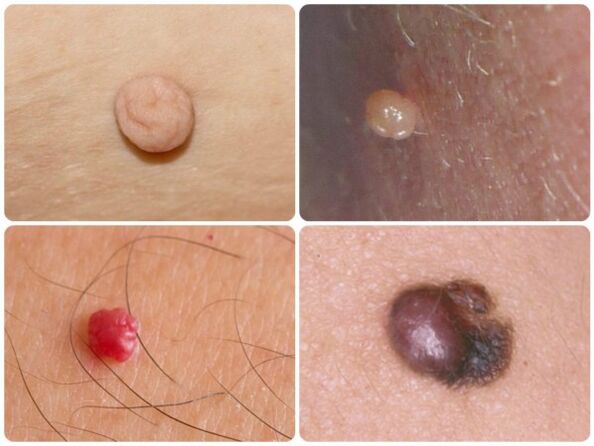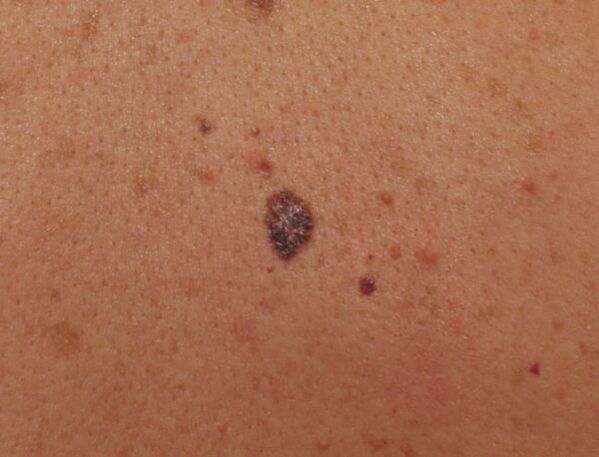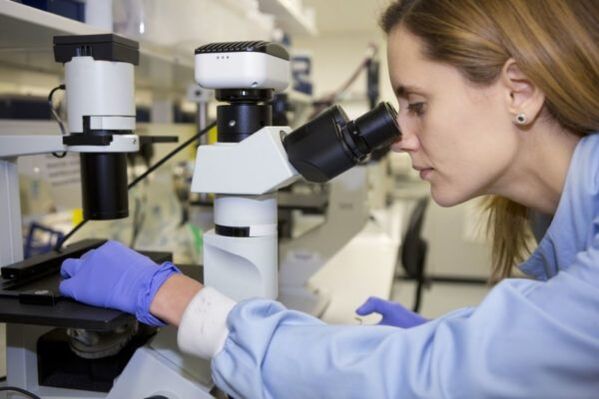Papillomas on the neck do not create obvious discomfort, but spoil the appearance. These neoplasms grow when the human papillomavirus (HPV) enters the body. The only exception is growths, which are often damaged. To get rid of papillomas on the neck, specialized intervention (most often surgical) will be required.

Causes
Papillomas are benign neoplasms that result from HPV infection. Doctors isolate more than a hundred viruses that can cause such growths to appear in the body. Hanging warts of small size often appear on the neck, they reach 2-3 cm in diameter.
Human papillomavirus infection occurs through direct contact with an HPV carrier. It is also possible to transmit the pathogen through personal hygiene items or clothing. The virus can enter the baby's body in the womb or during birth.
The possibility of papillomas depends directly on the state of immunity. With a weak body defense, the first growths appear a few days after infection.

Reasons for the appearance of neoplasms in the neck include:
- frequent damage to the skin epithelium;
- allergic reactions;
- severe stress;
- respiratory diseases, helminthic infestations;
- long-term use of a number of medications;
- overweight;
- bad habits;
- non-observance of hygiene rules.
In women, hormonal imbalance during pregnancy, during menopause or due to taking contraceptives is considered as one of the common causes of growth formation.
If small growths appear on the neck, then no specialized treatment is often required. In the absence of exposure to provocative factors, such warts disappear without external intervention in three years.

Types and symptoms
Of all the types of neck papillomas, the following types grow:
- Filiform- look like small bumps with a yellow surface. In the future, a foot appears, through which the growth is attached to the skin. Filiform papillomas are flesh-colored or light brown.
- Flat- formations of this type protrude slightly above the surface of the cervix. The color of flat growths does not differ from the shade of neighboring tissues. Over time, they coalesce with each other, thus enlarging the affected area, and sometimes itching.
- Keratopapilloma- occur mainly in people over 30 years old, are round or longitudinal.
- seborrheic- are distinguished by the presence of a fragmented surface. These growths are often painful.
- Simple (vulgar)- this type of papilloma is localized in the upper limbs, but they sometimes grow on the neck or face. The growths look like rounded warts, which protrude visibly over the skin.
Most papillomas are single. But in case of damage to the affected area or against the background of a significantly weakened immunity, the virus spreads to new areas, which leads to the appearance of multiple neoplasms.

Papilloma growth is not associated with severe symptoms. In rare cases, the activity of the virus causes:
- itching;
- burning;
- pain.
When the problem area is damaged, the affected areas begin to bleed.
Possible consequences
Complications caused by papillomavirus activity are often caused by the actions of the carrier of the infection. Frequent growth injuries cause:
- Development of papillomatosis. This pathology is characterized by numerous growths that form in a small area of the body. In extreme cases, the entire cervical region is affected. This is explained by the fact that each wart contains the smallest particles of the virus, which, when the neoplasm is damaged, spreads to healthy areas.
- Degeneration into a malignant tumor. Malignancy is also more often due to neoplasm trauma. The damage leads to the development of an inflammatory process in the problem areas.

Papillomas in the neck are more often exposed to external influences, as a result of which open wounds are formed on the skin. Because of this, the affected area is often infected with pathogenic bacteria, which leads to inflammation and ingestion of the epidermis.
Therefore, if the wart comes out and bleeding starts in the problem area, it is necessary to treat the damaged skin with an antiseptic composition and close it with a bactericidal plaster. In addition, it is recommended that you consult a dermatologist within two to three days to rule out the possibility of complications.
diagnostic
Papillomavirus causes characteristic growth. However, in some cases, it is not possible to distinguish warts from other similar neoplasms.
To rule out other diseases manifested in the form of skin rashes, the following diagnostic measures are performed:
- PCR (polymerase chain reaction). Allows not only to diagnose the presence of a virus in the body, but also to assess the possibility of tumor degeneration.
- Histological analysis. It is prescribed for the suspicion of a malignant tumor.

The Digine test is considered the most effective. This method is very sensitive and provides information on the presence of papillomavirus, the type of infection and the degree of oncogenicity.
Therapeutic techniques
To remove papillomas on the neck, you should see a dermatologist. It is not recommended to engage independently in the removal of neoplasms from the skin. This is especially true in cases of multiple tissue damage, which indicates a state of immunodeficiency.
In the treatment of papillomavirus, hardware techniques and medicines are used. The latter cope well with single growths of a small size.
Medication therapy
Drug therapy is performed mainly with the use of topical preparations.
To quickly remove warts from the neck, you can use special pharmacy products.
Using medication does not always help to get rid of papillomas. Moreover, this method of treatment does not exclude the possibility of the appearance of neoplasms in the same place.
Hardware techniques
To remove papillomas from the neck, the following hardware removal techniques are used:
- Laser coagulation- allows you to remove neoplasms from the skin with minimal risk of infection or bleeding.
- Cryodestruction- the procedure provides treatment of problem areas with liquid nitrogen, which destroys tumor cells.
- Electrocoagulation- tumors are removed from exposure to high frequency current. This method is more painful than previously described.
- Removing the radio wave- the method allows not only the removal of the tumor, but also the taking of tissue for subsequent histological examination.
In rare cases, removal of the tumor from the neck is done by surgery.
ethnoscience
Home treatment can be done with folk remedies. They help to remove not only smaller tumors, but are also effective in fighting large growths.

To cope with papillomas in the neck will help:
- olive or beaver oil. With this tool, it is necessary to lubricate problem areas several times a day;
- apple cider vinegar or ammonia. Each of these funds should first be applied to a cotton swab and applied for a few minutes under construction. The procedure should be performed no more than once a day;
- aloe juice. They should soak a cotton swab, which is applied to the problem areas and held for 4-5 hours;
- tea tree oil. It is enough to apply two drops of the product every day on the skin neoplasm;
- celandine solution. To prepare it, you will need to mix the plant juice with water in equal proportions. The product is stored for two weeks in a dark place. The resulting drug should be taken daily, 15 drops.
Regardless of the chosen method of fighting papillomavirus, treatment should be supplemented with measures aimed at strengthening immunity. For this, it is recommended to take vitamin complexes and immunomodulators. From traditional medicine, decoctions from herbal lemon balm preparations, plantain leaves, dandelion root and other herbs help strengthen the immune system.
Prophylaxis
It is quite difficult to prevent human papillomavirus infection. But if you follow the rules of prevention, you can avoid the appearance of neoplasms in the body. This requires:
- wash your hands and body daily;
- Healthy food;
- timely treatment of diseases;
- rejection of bad habits;
- leads an active and healthy lifestyle.
If warts appear on the neck, it is recommended to be examined by a doctor in order to rule out malignant neoplasms. It is imperative to consult a dermatologist if the wart has changed color or numerous growths appear on the skin.























